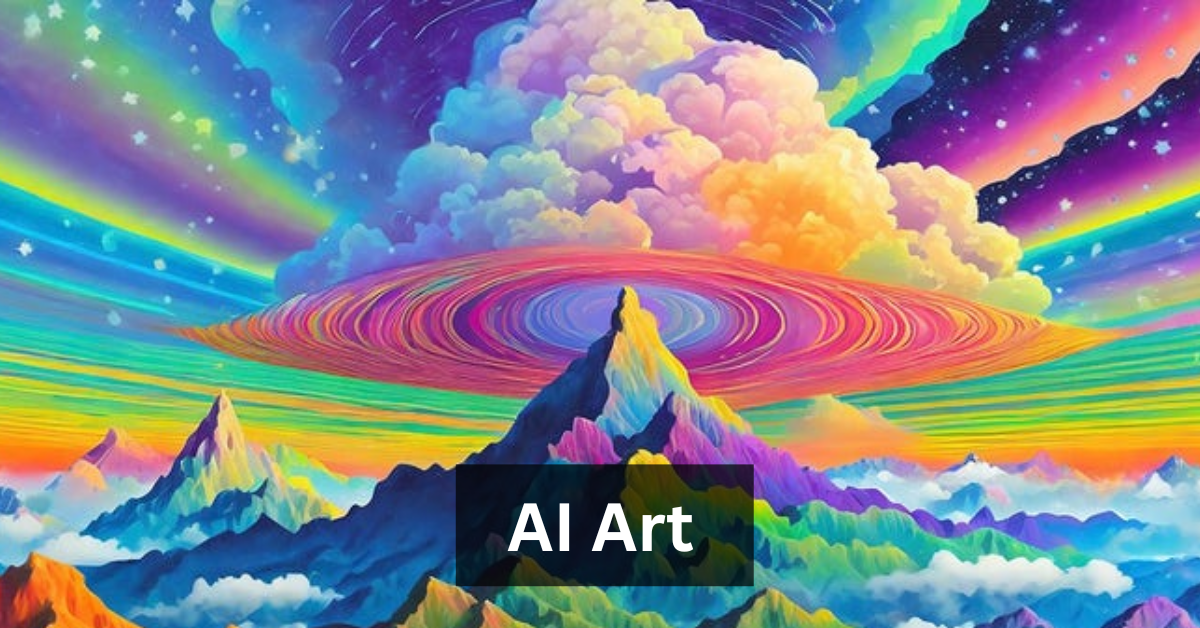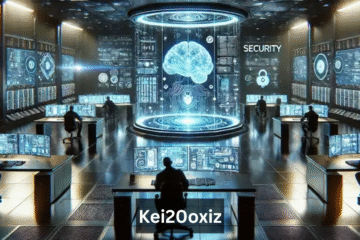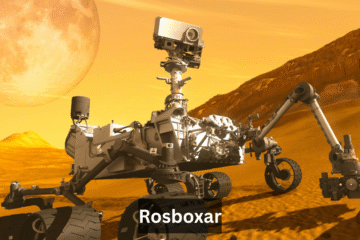AI Art is artwork created using artificial intelligence algorithms that generate images based on text prompts or image inputs. Powered by artificial intelligence and machine learning, AI art tools have made it possible to transform ideas into visually stunning artworks instantly. What once took hours of manual drawing or digital design now takes mere seconds with the help of advanced algorithms. As AI becomes more accessible, artists, designers, and even casual hobbyists are using AI-generated art to enhance their projects, expand their creative boundaries, and experiment with visual storytelling in ways never before imagined. Whether you’re a seasoned creator or just curious, understanding AI Art will give you a front-row seat to the future of visual expression.
What Is AI Art?
AI Art refers to any artwork that is generated or assisted by artificial intelligence. At its core, it involves using AI algorithms—especially neural networks and machine learning models—to create images based on human input, typically in the form of text prompts or image references. These models are trained on vast datasets of existing artwork, photos, and design styles, allowing them to learn how to mimic human creativity. With this learned knowledge, AI tools can now generate everything from photorealistic portraits to whimsical fantasy scenes and abstract compositions. The result is a form of art that looks human-made but is algorithmically produced. It’s not just a shortcut—it’s a redefinition of the creative process, blending computational power with imaginative potential.
How AI Art Works: The Technology Behind the Magic
AI art is made possible through a combination of advanced technologies such as neural networks, GANs (Generative Adversarial Networks), diffusion models, and CLIP (Contrastive Language–Image Pre-Training). GANs, for example, involve two neural networks that work against each other—one generates images while the other evaluates them for realism. Diffusion models, such as those used in DALL·E and PicLumen, start with random noise and gradually refine it into a coherent image. CLIP, on the other hand, allows the AI to understand and interpret text descriptions accurately, making it possible to create images directly from natural language input. Together, these technologies allow AI art tools to turn simple words into complex visuals that reflect lighting, style, texture, emotion, and more.
The Rise of AI Art: Why It’s Booming in 2025
In 2025, AI art has moved far beyond novelty—it’s now a dominant force in both digital and commercial spaces. What’s driving this surge? Accessibility plays a major role. With platforms like PicLumen offering intuitive user interfaces, even those without any design experience can create professional-grade artwork. Speed is another factor. Marketers, content creators, and businesses appreciate the ability to generate high-quality visuals on demand. Add to this the rise of NFTs, digital products, and visually driven social media platforms, and it’s clear why AI art is everywhere. It’s not replacing artists—it’s empowering a new generation of creators with tools that reduce time, boost creativity, and open new economic opportunities.
Popular AI Art Generators You Should Know
Several AI art tools have captured the attention of creators worldwide, each offering its own set of strengths. PicLumen stands out as a powerful yet user-friendly platform that enables deep customization and delivers high-resolution results. DALL·E 3, developed by OpenAI, is known for its detailed interpretation of complex prompts. Midjourney excels in producing highly stylized, fantasy-inspired visuals with a dramatic flair. Stable Diffusion offers open-source flexibility and customization for tech-savvy users. Meanwhile, Runway ML expands AI art into video and motion graphics, and Artbreeder allows users to blend and evolve images collaboratively. These platforms represent the diverse ecosystem of AI art tools available today, each catering to different needs and aesthetics.
Why PicLumen Stands Out Among AI Art Platforms
Among the growing list of AI art generator, PicLumen has earned its place as a top choice for both beginners and professionals. What sets PicLumen apart is its versatility. With a rich selection of artistic styles—from hyper-realistic portraits to watercolor dreamscapes—it offers users the ability to create exactly what they envision. Its intuitive interface is easy to navigate, making it perfect for those just starting out. Advanced features like AI Replace, Image Extender, and Upscaler allow more experienced users to fine-tune their creations to professional standards. Whether you’re creating digital artwork for your portfolio, branding materials for your business, or simply experimenting with visual storytelling, PicLumen is equipped to deliver exceptional results.
How to Create Stunning AI Art with PicLumen (Step-by-Step Guide)
Getting started with PicLumen is simple and rewarding. First, you’ll need to create a free account on the platform’s website. Once logged in, you’ll be taken to a dashboard where you can either explore artwork created by others or begin your own creation. In the “Create” section, you’ll find a prompt input box—this is where the magic begins. Enter a text description of the image you want, such as “A futuristic city skyline at night with glowing lights and flying cars.” Next, choose from a variety of artistic styles to set the tone and mood. Adjust the resolution based on your needs—higher for print quality or lower for quick digital sharing. After hitting “Generate,” the AI gets to work and delivers your artwork in seconds. You can download, refine, or even upscale the result, all from within the platform.
Best Practices for Writing Prompts That Get Great Results
The quality of your AI art output heavily depends on the prompt you provide. The more descriptive and intentional your input, the better the AI can understand your vision. For instance, rather than writing “a flower,” you could try “a close-up of a dew-covered red rose in early morning sunlight.” Be sure to include mood (e.g., mysterious, joyful), style (e.g., watercolor, digital painting), and perspective (e.g., bird’s-eye view, close-up) where applicable. Adding keywords related to color, lighting, environment, and time of day helps fine-tune the output. Over time, you’ll learn how to balance simplicity with detail, creating prompts that consistently yield beautiful, relevant, and unique results.
Exploring AI Art Styles: From Realism to Abstract and Fantasy
AI art isn’t confined to one artistic genre. One of its greatest strengths is its ability to replicate and invent a broad spectrum of visual styles. Want a hyper-realistic portrait? PicLumen can deliver facial detail that rivals a photograph. Prefer a dreamy, impressionistic landscape in the style of Monet? Just ask. Whether your aesthetic leans toward minimalism, dark cyberpunk, bright cartoon graphics, or abstract chaos, AI art generators can accommodate your taste. Some creators even use AI to develop entirely new styles that don’t follow traditional art norms, blurring the lines between human and machine innovation. This adaptability makes AI art ideal for everything from personal projects to brand identity design.
Use Cases of AI Art in the Real World
The practical applications of AI art are vast and growing every day. In marketing, companies use AI-generated visuals for social media graphics, advertisements, and product packaging. In publishing, authors use AI art for book covers and interior illustrations. Artists are launching NFT collections based entirely on AI-generated images. Game developers use AI to produce concept art, character design, and world-building assets. Teachers use it as a tool for visual learning in the classroom. For entrepreneurs, AI art reduces costs and speeds up timelines. The ability to generate custom, royalty-free visuals makes AI art a game-changer in every creative industry.
Advanced Features of PicLumen for Professional-Grade Artwork
For users who want more control over their creations, PicLumen offers a suite of advanced tools. The AI Replace tool allows you to select and modify specific parts of an image without starting over—perfect for correcting small elements or making iterative changes. The Image Extender expands artwork beyond the original canvas, ideal for adding background depth or converting square images into banners or widescreen formats. The AI Upscaler enhances image resolution, allowing you to print large, high-quality versions of your creations. These features make PicLumen not just a generator but a complete creative studio, allowing users to refine, enhance, and export artwork that’s truly ready for commercial or personal use.
AI Art vs. Human Art: Complement or Competition?
A common debate surrounds whether AI art threatens traditional artists or complements them. The truth is more nuanced. While AI can automate certain aspects of creation, it lacks emotional nuance, cultural context, and intentionality—qualities that human artists bring to their work. Instead of replacing artists, AI art tools can be seen as collaborative partners. Many digital artists now incorporate AI into their workflows as a starting point, saving time and inspiring new ideas. By blending human creativity with machine precision, we unlock a hybrid model of artistry that expands rather than limits creative expression.
Can You Sell or License AI Art? Legal & Copyright Considerations
As AI-generated art becomes more common in commerce, questions of ownership and copyright are rising. Most AI platforms, including PicLumen, allow users to license, sell, and distribute the art they generate—especially if it’s made with a paid plan. However, legal frameworks are still evolving. Some jurisdictions don’t recognize AI-generated art as copyrightable without significant human input. To stay safe, always read the terms of service of your chosen platform, and consider adding human refinement to your art if you plan to commercialize it. As laws catch up to technology, expect more clarity in how AI art fits into the global intellectual property ecosystem.
Tips for Beginners: How to Get the Most Out of AI Art Generators
If you’re just starting your journey with AI art, keep these tips in mind. Start simple with short prompts and experiment with different styles. Use the Explore tab on platforms like PicLumen to see what others are creating. Don’t be afraid to iterate—run the same prompt multiple times to get variations. As you get more comfortable, try writing layered prompts or using tools like Replace and Extender for deeper customization. Join online AI art communities to get feedback and stay inspired. Most importantly, treat the tool as a creative ally. The more you use it, the more you’ll unlock its full potential.
The Future of AI Art: Creativity in the Age of Algorithms
Looking ahead, AI art is set to become even more integrated into creative industries. We can expect smarter algorithms, real-time 3D generation, personalized style training, and even immersive VR-based creation environments. Educational institutions are already incorporating AI art into design curriculums, and more platforms are being developed to help creators monetize their AI-generated work. With the rise of generative media, AI art will play a key role in shaping how stories are told, products are marketed, and brands are built. It’s not just a trend—it’s the next frontier of creativity.
Conclusion
AI art isn’t just about making images—it’s about expanding the creative process. It allows everyone, regardless of skill level, to produce beautiful, meaningful visuals with just a few keystrokes. Whether you’re designing a poster, launching a business, illustrating a book, or just exploring your imagination, AI tools like PicLumen offer a playground of endless possibilities. As technology continues to evolve, those who learn to harness its power will find themselves at the forefront of a new era in art. So why wait? Dive into the world of AI art today and discover just how far your creativity can go.
Frequently Asked Questions
Is AI art legal to sell or use commercially?
Yes, AI art can be sold or used commercially, especially if generated through platforms that grant user rights—always check the platform’s terms of use.
Do I need art skills to use AI art generators?
No, AI art tools like PicLumen are beginner-friendly and require no prior design experience.
What are the best platforms for generating AI art?
Popular platforms include PicLumen, Midjourney, DALL·E 3, and Stable Diffusion, each with unique features and strengths.
Can AI art replace human artists?
AI art complements human creativity but doesn’t replace the emotional and conceptual depth of human-made art.
Stay in touch to get more updates & alerts on Erome! Thank you



